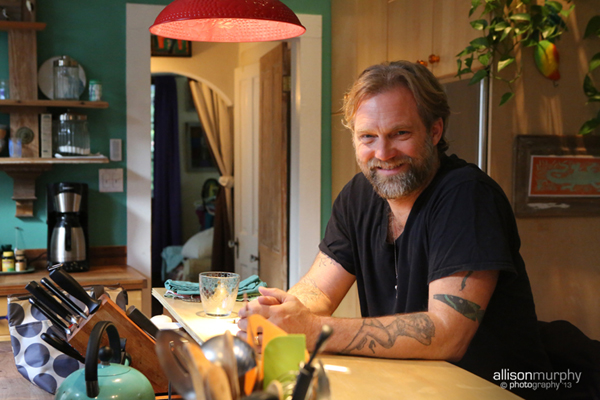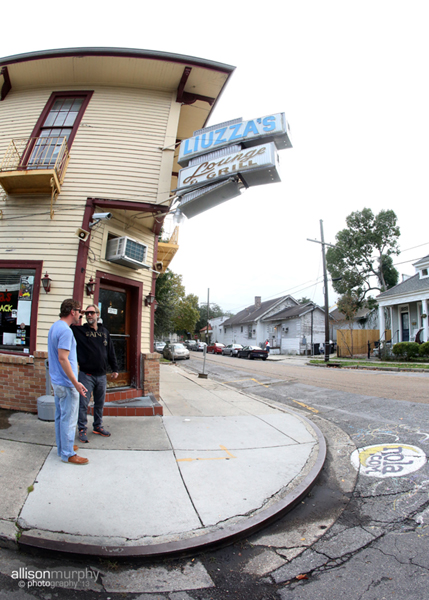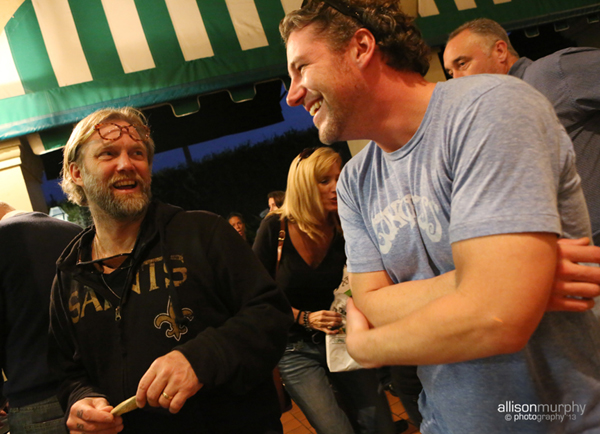Anders Osborne’s New Orleans

Photos by Allison Murphy
New Orleans is a city saturated with history, and its soul seeps from every board in every building, spilling out onto the streets and putting a spell on those who walk them. Some come for debauchery, others for the food, and a few come because they were called to a place that was always meant to be their home. Anders Osborne is one of those people who was summoned by the magic of New Orleans.
Over the years I have interviewed many musicians from the Crescent City, but for some reason never made my way there. Those conversations conjured a yearning for the city that was nearly uncontrollable for me. My dreams were haunted with images of sweat-filled nights sparkling with brass, second lines heralding a city to dance and Big Chiefs in full dress chanting as they pass. While interviewing Anders Osborne backstage this summer his response to one of my questions made me ask my own. The question to Osborne was simple, “What was your life like before New Orleans?”. His answer, “I didn’t have one,’ was profound.
That was the last straw for me. If New Orleans meant so much to all these musicians, then I at least needed to go see it for myself. After explaining I had never visited the city, and how I felt drawn to it, I asked Osborne if he would show me around the city he has called home for 30 years. He immediately agreed, and a few months later I hopped on a plane bound for the Big Easy.
Osborne, like everyone I have met in New Orleans so far, is very proud of the city. Residents want you to experience everything they love about NOLA, and want to you fall in love with it as well. My tour started in Osborne’s kitchen, where he took out his iPad to show me a map of the city. After a crash course in Nola geography, Osborne and I hopped in the car so he could show me some places that are dear to his heart, and share a bit of his personal history here in New Orleans.

Leaving the Mid-City neighborhood we got “Back On Dumaine,” crossed Bayou St. John, and headed down to one of Osborne’s favorite restaurants, Liuzza’s By The Track. Out of all the restaurants in New Orleans, I asked Osborne why he loved Liuzza’s so much. He stated, “I found this place as soon as I got to New Orleans when I was 18. That was 30 years ago. I think that a lot of things you discover in your youth stick with ya. Liuzza’s is a real mom and pop place with authentic New Orleans food. Today is Monday, so we are going to have red beans and rice. Red beans and rice is a tradition here on Monday. They are also known for their barbeque shrimp, but it’s not shrimp season now. Now it’s oyster season. Oyster season is in the winter. The colder the water, the better the oysters. Crawfish season comes in the spring. Then shrimp in the summertime, crab seasons right after that. Always eat with the seasons.”
Food is an important part of life here In New Orleans, but it is not why Osborne calls the city home. According to Osborne, “People ask me about the music and the food, but it’s the whole package. It’s the intangible. New Orleans is a place where you get to be yourself, and you are celebrated for being yourself. You don’t have to conform here. The way you are is the way the city wants you to be. Some people are born into a place and stay there. I feel that most people are born in one place but designed for somewhere else. You have to ask yourself more than ‘What do I want to be when I grow up,’ you also need to ask ‘Where do I want to be? Where do I need to be?.’ I came here when I was 18 and just knew that I was ok here. And that’s why I stay. I need to be here”.
Osborne attempted to leave New Orleans once, but it didn’t take long for him to realize that focusing on his music in New Orleans should be his priority. Anders shared, “When I was 20 I went to LA and couldn’t get a job, so I found a job in Los Alamos. I got a job as a chef because I lied and said I could cook. It was funny man. I held on for five months. I had to call my brother and uncle, who are both chefs, and told them they had to send my some recipes and tell me how to do shit. Five months into it I got this Sunday afternoongig at alittle bar called The Grill. That Monday I went into work and the owner said, ‘I went to see you yesterday. It was really good. That’s what you should be doing.’ Then he gave me my notice.” As Osborne finished the sentence one of his songs came through the speakers of Liuzza’s and the staff gave him a glance he didn’t notice. It was then I realized this city loves Osborne as much as he loves the city.
Leaving Liuzza’s and heading to St. Louis Cemetery #3 via Esplanade,Osborne continued his guided tour with detailed commentary,“So that’s where Jazz Fest is. The tracks brah. I lived in a tiny little shotgun on Bayou St. John on Marsh St, and the cemetery was my backyard. One night my roommate and I had a little gathering, and I met Sarah. Wejumped the fence into the cemetery and the rest is up to your imagination. Pretty groovy shit…that’s all I can say about that…and I ain’t gonna let you know how many people were involved!” After a deviant laugh he continued, “There was some kinda ritual goin’ on that night. Eight months later I proposed to her there. This is Bayou St. john on our left.And that spot right there is where the first settlers made a trade with the natives. That exact spot is the original New Orleans. I didn’t know that at first, but it always felt like a scared place. There are three ridges that meet here-Gentilly Ridge, Metairie Ridge and Esplanade Ridge. These are high points that supposedly never really flood, even 300 years ago. That’s why the original settlers built on it.”

After leaving the cemetery Osborne pointed to City Park and said, “Let’s pull in there.” We drove pastlive oaks adorned with spanish moss, magnolia trees and canary palms; all identified by Osborne. Parking near a pond and Greek pavillion Osborne revealed, “This is a special spot I discovered when I lived in The Quarter during the late 80’s,early 90’s. I would come here every day. The French Quarter didn’t really provide much solitude, so this is where I would come to find it.”
Leaving City Park we headed down to Jackson Square and the riverfront via The French Quarter. Osborne explained, “So this is the end of The French Quarter. There’s the famous Port Of Call that serves a huge fat greasy burger. 13 blocks that way is the beginning. Canal St. and Esplanade Ave. frame it. Then Decatur St. and Rampart St. frame it the other way. That’s the Mississippi River over there. Right there to your left is the first US Mint. That’s my old house over there. The second floor with the balcony. Decatur and Barracks”. A few blocks later he continued, “This was my other apt, 1229 Decatur. That’s Mollys At The Market. They have the best fucking irish coffee. I wish I still drank that shit, cause it was good. Tujague’s over here has been around a long time and is really good. The garlic chicken is amazing. WWOZ is right over there. Great radio station.”
We pulled into a public parking lot by the river and walked down into Jackson Square. Osborne offered, “I started playing on the streets here. I watched Rebirth Brass Band get started here. I saw Trombone Shorty here was he was like four years old. I would sit down here and play on the streets. There were always a lot of people playing down here. Some were very auspicious and very good at street performing. I wasn’t. I was very shy and didn’t make a lot of money. During the weekends this is all packed with artists who have reserved spaces to vend. Jackson Square is the focal point of the essential New Orleans. The ridges by the cemetery we were at before is the original New Orleans, but this right here is the city’s essence. It hasn’t changed. Generations have come and gone, but the place is still the shit. All the artists, the mysticism…that’s St. Louis Cathedral over there. On Mardi Gras Day we all go ape shit around here and parade around with the Jesus freaks who would hold a cross and damn us and say we all are going to hell. They stand right over there.”

Walking up to the monument in Jackson Square, Osborne pulled out a tidbit of information I had never heard. Pointing to the statue of a soldier on a horse Osborne explained, “When the horse is standing on its two back legs, that means the person died in battle. When there is only one leg up it means they were wounded”. After the tour and history lesson we grabbed a cafe au lait at Cafe Du Monde before heading back up to Osborne’s home. On the way back we drove by a bar called Checkpoint Charlie’s and Osborne shared how much that place meant to him, “When the restaurant had just opened in 1990 the only live music they had was Jack Quigley and His Only Friend on Mondays. It was a solo act. I was looking for a steady gig, a residency, which really works in New Orleans to get your start. That’s how Rebirth got all their start. That’s how I got my start. Even after I had been successful, I re-started my career at Chickie Wah Wah by doing the Tuesdays there. You just establish a local rapport, and then you become part of the fabric of things. You aren’t an entertainer that comes and goes randomly, you are part of everything. I really think it makes you a stellar musician. Not to toot my own horn, it just changes everything. So anyway, Quigley would be there on Monday’s, so I went in looking for weekday gig. They had a laundromat, pool tables, a bar and hamburgers. I mean isn’t having a laundromat in a bar like the smartest thing you’ve ever heard of? It served strippers, musicians, bartenders, vagrants. We would all go there to drink after work and do our laundry. Brilliant. Anyway, the owner said, ‘Well I got Jack on Mondays. I’ll give you Tuesdays. You get 20% of the ring [the bar], all you get all you can eat and all you can drink.” I said, ‘I like Tuesdays.’ My first night there was nobody in this place, brah. It was a brand new place. There was one stripper, two vagrants and an old alcoholic. That was it. Week in and week out it stayed that way.
“Then a couple months later some pool sharks joined the crowd, then some more musicians. About a year or so into it the place was fucking hopping. Now there was music on Wednesday and Thursday too. They had this UNO jazz free improv, and Brian Blade was the drummer. He was 16. That lasted 6 months, it just didn’t bring enough people in. Then they had this band called Irene and The Mikes from The West Bank. It was biker style rock and roll, and they were on mushrooms and acid all the time. It fit perfect. So now they had a solo singer songwriter on Monday, me on Tuesday, and then they had Irene and The Mikes with psychedelic fucking light shows. All of a sudden that Wednesday was the most hopping night in the city of New Orleans man! Now Checkpoint Charlie’s was becoming a mecca. Then they added Kenny Holiday on Thursdays. That was all they would do man. Mondays thru Thursdays. They didn’t need to have music on the weekends because we were all there anyway, so it was always packed. It was the most clever thing I had ever seen. They just skipped the weekends and didn’t have to pay people the big money. I mean, it was really a great scene. Some of the best naughtiness you could ever perform has taken place there. It was a magical place. We created it. There wasn’t a scene on Frenchmen St. then. There was only Cafe Brazil. I mean Checkpoint Charlie’s was my college and grad school. There were writers, pool sharks and all kinds of interesting people from all over the world that moved to New Orleans. So yeah, Checkpoint was where it all started for me. They do karaoke there now, and the karaoke guy yells at you. It’s a little weird. New Orleans is always changing, but it always remains the same.”
Osborne may not have been born in Louisiana, but New Orleans birthed a new life for him. He is as connected to this city as anyone could be, and he could hardly contain his enthusiasm while showing me places he has seen probably thousands of times over the past 30 years. Brimming with love for his city and well versed in its history, Osborne made me wonder why I should ever leave. So I am not. Osborne’s tour of New Orleans thoroughly convinced me that this is where I need to be when I grow up, and I’ve decided that now it’s time for me to be reborn here.



















